
Ancient Assyrian clothing Archive
What did the clothing in Mesopotamian look like? Let's do a Sumerian costume breakdown. Basically, fashion changes when the world changes. And in Mesopotamia, fashion didn't need to change for 5,000 years. When we look at the sculptures or drawings from that era, we see dull and neutral colors and shapes, but was it really so?

Assyrian women in 2021 Assyrian women, Traditional outfits, Clothes
The Assyrian Empire started off as a major regional power in Mesopotamia in the second millennium B.C.E., but later grew in size and stature in the first millennium B.C.E. under a series of powerful rulers, becoming one of the world's earliest . empires.. Assyria was located in the northern part of Mesopotamia, which corresponds to most parts of modern-day Iraq as well as parts of Iran.

Christian (Assyrian) women from Mardin, in their festive attire. Late
Fashion and dress in Mesopotamia - clothing, footwear, and accessories - was not only functional but defined one's social status and developed from a simple loincloth in the Ubaid Period (c. 5000-4100 BCE) to brightly colored robes and dresses by the time of Sassanian Empire (224-651 CE).

Assyrian Warrior Outfit for Genesis 8 Male(s) Daz 3D
The civilizations that developed in Mesopotamia near the Tigris and Euphrates Rivers between 3000 and 300 b.c.e. developed impressive skills for fashioning clothing. The evidence of these civilizations' clothing remains on sculptures, pottery, and in writings left on tablets and royal tombs.

Pin on костюм
The oldest civilization in Asia is Mesopotamia, in which Sumer or Sumeria (lower region) was established. Native clothing originated in the third millennium (2500 BC). The primitive influence of cloths that wrap around the body, loose garments, and suits mixed with the contributions of many diverse civilizations.

Assyrian jewelry Assyrian women, Medieval clothing, Historical fashion
Sources available for the study of clothing and textiles include material remains discovered via archaeology; representation of textiles and their manufacture in art; and documents concerning the manufacture, acquisition, use, and trade of fabrics, tools, and finished garments. Ancient Egyptian clothing This section has multiple issues.

Assyrian, Babylonian costume history. Mesopotamia. Costume History
ANCIENT WORLD: HISTORY OF DRESSEvidence about dress becomes plentiful only after humans began to live together in greater numbers in discrete localities with well-defined social organizations, with refinements in art and culture, and with a written language. This happened first in the ancient world in Mesopotamia (home of the Sumerians, Babylonians, and Assyrians) and in Egypt.

Pin on Babylon
This latter period included the Byzantine era. Ancient Egyptian and Assyrian Dye Colours Typical Ancient Egyptian and Assyrian Dye Colours included blue, red, yellow, green and purple. Blue - a dark indigo. You will be aware indigo fades so it was sometimes paler blue. Red - similar to Indian red. Yellow - similar to yellow ochre.

Assyrian King Stock Photo 18115337 Alamy Ancient babylon, Babylon
Assyria (Neo-Assyrian cuneiform: , romanized:māt Aššur) was a major ancient Mesopotamian civilization which existed as a city-state from the 21st century BC to the 14th century BC, then to a territorial state, and eventually an empire from the 14th century BC to the 7th century BC.. Spanning from the early Bronze Age to the late Iron Age, modern historians typically divide ancient Assyrian.

Assyerian Ancient history, Ancient mesopotamia, History
The dress worn in Mesopotamia by the Babylonians (2105-1240 bce) and the Assyrians (1200-540 bce) evolved into a more sophisticated version of Sumerian and Akkadian styles. Ample evidence of this more elaborate draped costume can be seen in the large relief sculptures of the age.

10 best Assyrian & Babylonian Costume images on Pinterest Ancient
Ancient Assyrians' clothing was not very elaborate. Men typically wore tunics with skirts or long robes made of wool, though the upper class might have used cotton or linen as materials since they.

ассирия Ancient warfare, Historical armor, Ancient armor
Lorenzo Verderame, Clothing, Body, and Identity in First-Millennium Assyrian Rituals, in S. Gaspa and M. Vigo, Textiles in Ritual and Cultic Practices in the Ancient Near East from the Third to the First Millennium BC, AOAT 431, Ugarit-Verlag, Münster, 177-188.

Clothing from the ancient kingdom of Assyria, locatedin Mesopotamia. As
The Old Assyrian period (ca. 2000-1600 B.C.) is the earliest period for which there is evidence of a distinct culture, separate from that of southern Mesopotamia, flourishing in the city of Ashur (also called Qal'at Sherqat), located on the Tigris River in modern Iraq.

Costumes of Assyrians, Medes and Persians in ancient times. Costume
The Babylonian Empire (about 2000 B.C.) had given place to the Assyrian Empire, which by the year 1300 B.C. had become the most powerful Asiatic state, and had absorbed the entire civilization of Western Asia. Fig. 34. The national dress both in Assyria and in Babylonia was a shirt with short, tight sleeves, cut very like the Egyptian kalasiris.

Assyrian Men em 2021 Roupas tradicionais, Mesopotâmia, Tradicional
Fig. 1 - Unknown. . Source: Menswear [To come…] CHILDREN'S WEAR References: Historical Context Wikipedia: Rulers: [To come…] [To come…] Source: Events: [To come… ] Timeline Entries katazome (stencil printing) 18th century, 19th century, ancient, Asia, K, P, S, term definition xicolli Americas, ancient, term definition, X eye of Horus

Assyrian, Babylonian costume history. Mesopotamia. Mesopotamia
Clothing in Ancient Assyria by Fred Aprim The Assyrian artist applied conventional terms in his representation of clothing. Simplicity was always resorted to in depicting fashion details, so that we tend to believe that the original costumes were more complex than displayed by the sculptor.